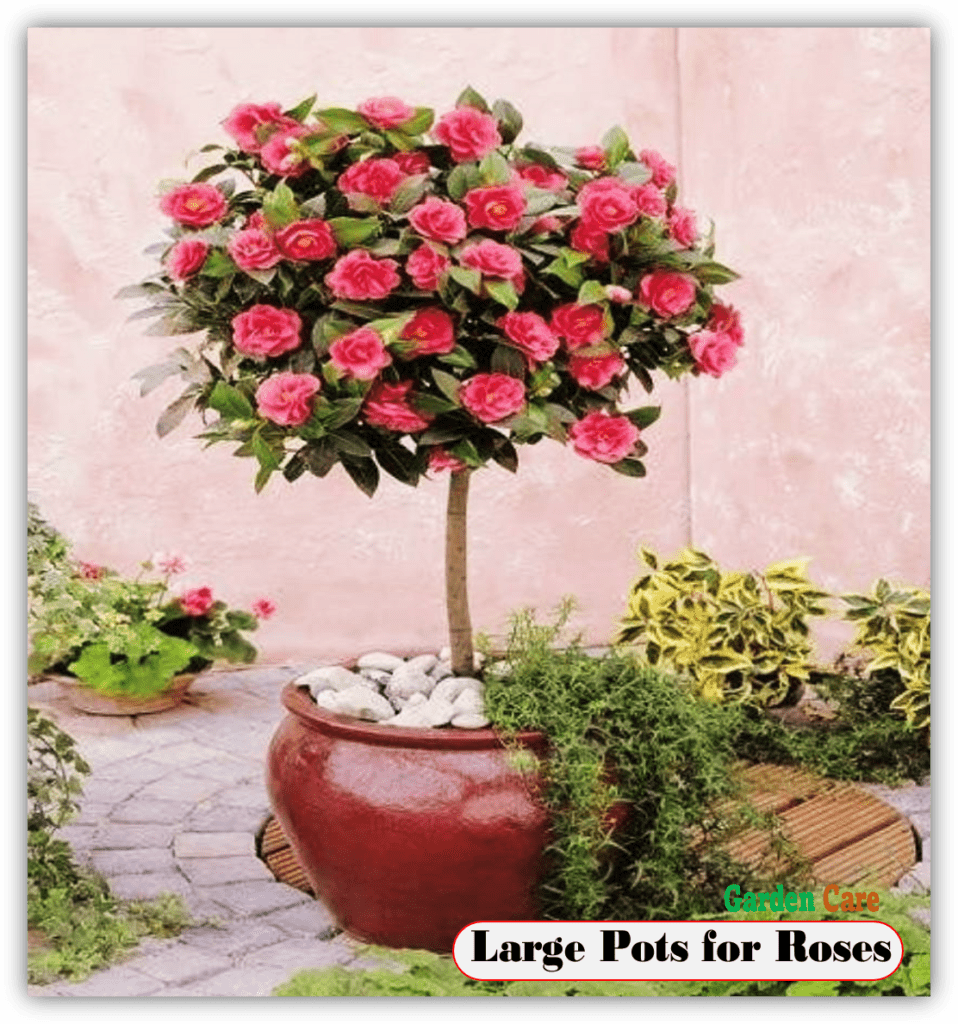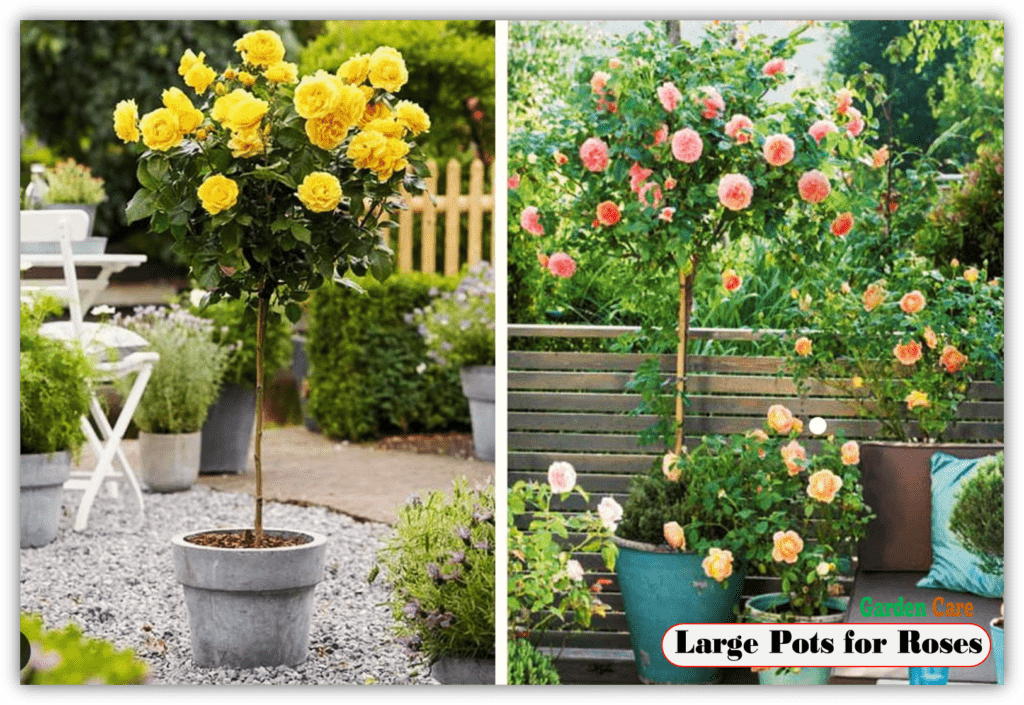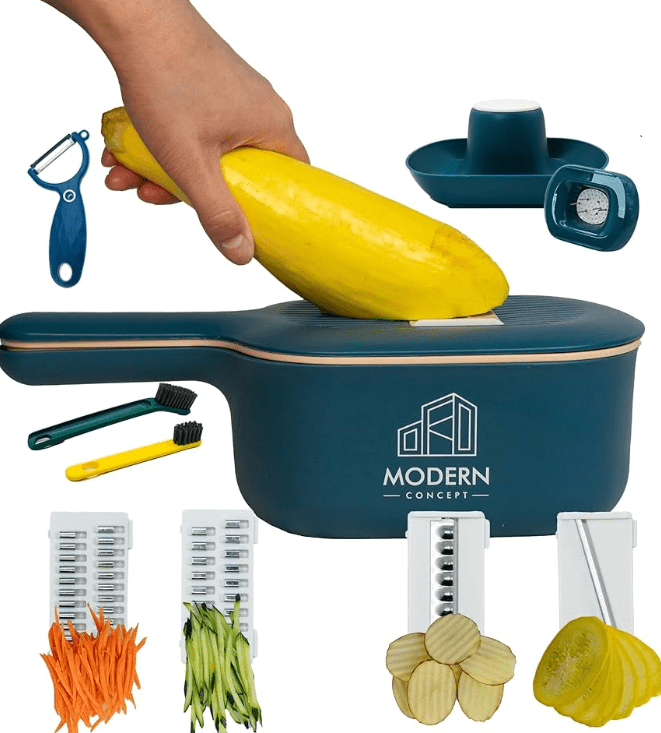Large Pots for Roses provide ample space for the roots to spread, ensuring healthy growth and abundant blooms. These pots offer the perfect environment for roses, allowing good drainage, air circulation, and room for the plants to thrive.
With the right size and material, large pots can enhance the visual appeal of your garden, creating a stunning display of color and fragrance. Whether you have limited space or simply want to create a focal point, large pots for roses are a fantastic option that allows you to enjoy the beauty of these stunning flowers.
Choose a well-draining potting mix and provide adequate water and sunlight for optimal growth.

Choosing The Right Pot Size
When it comes to growing vibrant and healthy rose plants, choosing the right pot size is crucial. Large pots provide ample space for root development and ensure adequate moisture retention, resulting in vigorous growth and stunning blooms. In this section, we will explore how to determine the ideal pot size and the different container materials available for your rose plants.
Considering Growth And Root Development
Roses are known for their strong growth and extensive root systems. To accommodate their growth and promote healthy root development, it is essential to choose a pot that offers sufficient space. When transplanting roses, keep in mind that the roots need room to spread out and anchor the plant firmly.
Additionally, a larger pot size allows for better aeration and prevents overcrowding of roots, reducing the risk of diseases and root rot. By providing ample space for root growth, you ensure that your roses have access to vital nutrients and water, resulting in stronger, more resilient plants.
Determining The Ideal Pot Size
So, how do you determine the ideal pot size for your roses? One common method is to match the pot size to the rose’s current root ball. A good rule of thumb is to choose a pot that is at least twice the width and depth of the root ball.
However, if you are starting with a bare root rose or a newly purchased rose, you can estimate the pot size based on the projected growth. Consider the mature size of the rose and select a pot that allows for future growth, providing enough room for the roots to explore and expand over time.
Exploring Different Container Materials
When it comes to choosing the right container material for your rose pots, several options are available:
| Container Material | Advantages | Considerations |
|---|---|---|
| Terracotta | Classic look, good breathability for roots | Can dry out quickly, may crack in freezing temperatures |
| Plastic | Lightweight, retains moisture well | May not provide as much breathability as terracotta |
| Fiberglass | Durable, lightweight, retains moisture | Can be expensive compared to other materials |
- Terracotta pots have a classic look and allow for good breathability, but they may dry out quickly and can be prone to cracking in freezing temperatures.
- Plastic pots are lightweight and retain moisture well, making them suitable for areas with hot and dry climates. However, they may not provide as much breathability as terracotta.
- Fiberglass pots are durable and lightweight, providing excellent moisture retention. They are a popular choice among gardeners but can be more expensive compared to other materials.
Ultimately, your choice of container material will depend on your climate, aesthetic preference, and budget. It is important to select a container that provides proper drainage, adequate space for root growth, and complements the overall look of your garden or patio.
Preparing The Pot For Planting
Before you begin planting roses in large pots, it’s important to prepare the pot properly. This will ensure that your roses have the best possible growing environment and will thrive for years to come. There are three key steps to follow when preparing the pot: ensuring proper drainage, adding high-quality potting mix, and picking the right location.
Ensuring Proper Drainage
Proper drainage is crucial for potted roses as it prevents waterlogged soil, which can lead to root rot and other issues. To ensure proper drainage:
- Choose a pot with drainage holes at the bottom. This will allow excess water to escape instead of pooling around the roots of your roses.
- Place a layer of small stones or broken pottery over the drainage holes. This will prevent the potting mix from clogging the holes while still allowing water to flow freely.
Adding High-quality Potting Mix
The right potting mix provides the essential nutrients and moisture retention that roses need to thrive in a container. Here’s how to add high-quality potting mix to your large pot:
- Fill the pot about halfway with potting mix that is specifically formulated for roses or other flowering plants. This will ensure it contains the necessary nutrients and pH balance for optimal growth.
- Gently loosen the roots of your rose plant and place it in the center of the pot.
- Add more potting mix around the plant, ensuring that the crown is level with or slightly above the soil surface.
- Press the potting mix gently around the roots to secure the plant in place.
Picking The Right Location
Choosing the right location for your potted roses is crucial for their overall health and growth. Consider the following when selecting a location:
- Ensure that your roses receive at least six hours of direct sunlight each day, preferably in the morning.
- Avoid placing your pot in a location that is exposed to strong winds, as this can stress the plants.
- Keep in mind that potted roses may require more frequent watering as the soil in containers tends to dry out faster than in garden beds.
By following these steps to properly prepare the pot for planting, you’ll give your roses the best possible start in their new home. With the right drainage, potting mix, and location, your potted roses will thrive, offering beautiful blooms and fragrance to brighten up any outdoor space.
Caring For Roses In Large Pots
Caring for roses in large pots is essential for their healthy growth and vibrant blooms. Provide proper drainage, regular watering, and adequate sunlight to keep your roses flourishing in their spacious containers.
Watering And Moisture Control
Proper watering and moisture control are essential for the health and vitality of roses in large pots. Roses require regular watering, especially during dry periods, to maintain healthy roots and promote optimal blooms.
When it comes to watering roses in large pots, it’s important to strike a balance between keeping the soil moist and avoiding waterlogged conditions that can lead to root rot. Use the finger test to check the moisture level of the soil. Insert your finger into the soil up to the first knuckle; if it feels dry, it’s time to water. On the other hand, if it feels damp, hold off on watering until it dries out a bit.
As a general guideline, roses in large pots typically require watering every 2-3 days, depending on the weather conditions. However, always consider the specific needs of your roses and adjust the frequency accordingly.
To ensure even moisture distribution, water the roses at the base of the plant rather than from above. This helps avoid wetting the foliage, which can lead to fungal diseases and other problems. Additionally, consider using a drip irrigation system or a watering wand with a gentle spray to provide a gentle and consistent flow of water.
Fertilizing For Optimal Blooms
Fertilizing your roses in large pots is crucial for promoting healthy growth and optimal blooms. Roses are heavy feeders and benefit from regular fertilization throughout the growing season.
When selecting fertilizer for roses in large pots, choose a balanced formula specifically designed for roses. Look for a fertilizer with a ratio of nitrogen (N), phosphorous (P), and potassium (K), such as 10-10-10 or 12-12-12. These nutrients support overall plant health, strong root development, and abundant flowering.
Apply the fertilizer according to the instructions on the package, typically spreading it evenly around the base of the rose and gently working it into the top layer of soil. Be cautious not to over-fertilize, as this can lead to excessive foliage growth at the expense of blooms.
For best results, feed your roses every 4-6 weeks during the growing season, starting in early spring and continuing until the end of summer. Remember to water the plants thoroughly after fertilizing to ensure the nutrients are properly absorbed.
Pruning And Deadheading Techniques
Regular pruning and deadheading are essential tasks for maintaining the health and beauty of roses in large pots. Pruning helps shape the plant, encourages new growth, and improves air circulation, while deadheading promotes continuous flowering.
Pruning should be done in late winter or early spring, before new growth begins. Use clean and sharp pruning shears to remove any dead, damaged, or diseased wood. Additionally, prune back any straggly or overcrowded branches to maintain an open and balanced structure.
Deadheading, which is the removal of spent blooms, is a simple yet effective technique to encourage new flower production. By removing the fading flowers, you redirect the plant’s energy from seed production to the development of new buds.
When deadheading, make clean cuts just above a healthy leaf node or set of leaves. This encourages new growth and prevents the development of long, leggy stems. Regular deadheading throughout the blooming season will keep your roses looking tidy and encourage a continuous display of beautiful flowers.
Protecting Roses In Extreme Weather
Roses in large pots are more susceptible to extreme weather conditions, such as freezing temperatures in winter or scorching heat in summer. It’s crucial to take steps to protect your roses during these challenging periods.
In winter, consider moving your potted roses to a sheltered location, such as a garage or shed, to protect them from freezing temperatures. Alternatively, you can wrap the pots with insulating material, such as burlap or bubble wrap, to provide an extra layer of protection.
During hot summer days, it’s important to provide adequate shade for your roses. Position them in a location that receives morning sun and afternoon shade, or utilize shade cloths to protect them from the intense midday sun. Additionally, make sure to keep the soil consistently moist during hot spells to prevent water stress.
If severe weather, such as heavy winds or hailstorms, is forecasted, consider temporarily moving the potted roses to a more protected area until the danger has passed. By taking these precautions, you can help safeguard your precious roses and ensure their long-term health and beauty.

Frequently Asked Questions On Large Pots For Roses
Do Roses Grow Well In Large Pots?
Yes, roses do grow well in large pots. They provide adequate space for root growth and can be easily moved.
What Are The Best Pots For Roses?
The best pots for roses are ones that provide good drainage and enough space for root growth. Opt for pots with drainage holes, at least 12 inches deep and wide, and made of durable materials like clay or plastic. Avoid pots that are too small or don’t allow water to drain properly.
Can Roses Survive Winter In Pots?
Yes, roses can survive winter in pots, but it’s crucial to take necessary precautions like insulating the pots and protecting them from severe weather conditions. Watering correctly and providing adequate sunlight are also important for their survival.
Can You Grow Roses In A 5 Gallon Bucket?
Yes, you can grow roses in a 5-gallon bucket. The bucket should have drainage holes to prevent waterlogging. Choose a suitable rose variety, ensure adequate sunlight, use rich soil, and provide regular watering and fertilization for healthy growth.
Conclusion
Using large pots for roses is a smart choice for any gardener. These pots provide ample space for the roots to grow, ensuring healthy and vibrant rose bushes. By selecting the right pot size, drainage, and potting soil, your roses will thrive in a container garden.
Consider the size and material of the pot, and choose a style that complements your outdoor space. Happy gardening!


